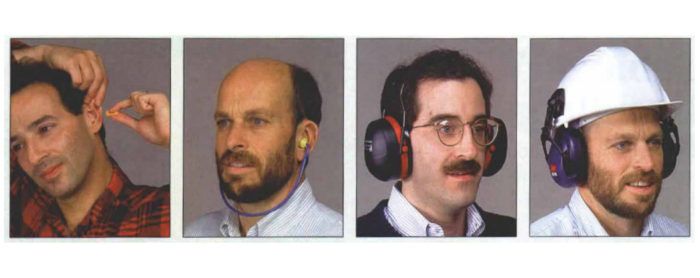Hearing-Loss Prevention
Earmuffs and earplugs provide inexpensive protection from job-site noise.

Synopsis: This article compares ear muffs, foam plugs, and other products designed to reduce the amount of damaging sound that reaches your ears. It includes pros and cons of each, charts listing noise levels produced by various tools, and a list of product manufacturers.
It’s the end of a long day on a noisy finish-carpentry job. While trimming the laminate on a new countertop, your partner says, “Hand me the trout, eh?”
“What?” you say, incredulous, a perplexed look on your face. He’s finally lost his mind, you think. “The router,” he says, louder this time. “Pass me the router.”
Turns out he hasn’t lost his mind but, rather, that you’ve lost a little of your hearing. You may be experiencing one of the early signs of noise-induced hearing loss, or NIHL. This type of hearing loss can be due either to long-term or to short-term exposure to high noise levels. One of the first signs of NIHL is an inability to distinguish common consonant sounds—in the example above the difference between an r and a t. As a result, people with NIHL usually recognize spoken words as garbled rather than as lower in volume. A word like fist may sound like fish.
There are no effective medical treatments for noise-induced hearing loss. Excessive noise damages the small hair cells that line the inner ear. This loss is usually permanent because, unlike most tissues in the body, the hair cells lining the inner ear do not grow back.
Hearing aids and other devices that amplify sound may not result in better understanding of speech if you have NIHL, just louder confusion. There are, however, effective alternatives to losing your hearing. Many inexpensive and simple methods exist both to prevent and to minimize hearing loss due to noise.
Noise on the job site
Recent estimates suggest that between 7 million and 10 million people work at jobs that expose them to hazardous noise levels. Many of these jobs are in the construction industry. Because of the magnitude of and the potential for work-related NIHL, the Occupational Safety and Health Administration (OSHA) has established guidelines for acceptable levels of noise exposure.
In the construction industry, OSHA considers exposure to an average of 90 decibels (db.) for an eight-hour workday to indicate the need for a program to protect against hearing loss. The OSHA-permitted duration of exposure to different noise levels without hearing protection is presented in the article in Table 1. As you can see, the amount of time considered to be safe decreases by one-half with every 5-db. increase in sound intensity.
Even at the level of protection mandated by OSHA, it is estimated that as much as 20% of the population still may experience some degree of hearing loss. This is because some people are more sensitive to loud sounds than others. So do not regard this table as the gospel; it merely represents general guidelines. When you calculate your safe-exposure time from this table, it is extremely important to be conservative.
Table 2 in the article compares the intensity of sound produced by many of the noise sources present on a job site. For reference, the intensities of some common sounds also are presented. The most widespread offenders in construction are power tools, compressors, and earth-moving equipment. Do not forget radios and tape players; the volume often gets turned up so the music can be heard above tools, worsening the potential for hearing damage.
For more photos, charts, and details, click the View PDF button below:
Fine Homebuilding Recommended Products
Fine Homebuilding receives a commission for items purchased through links on this site, including Amazon Associates and other affiliate advertising programs.

All New Bathroom Ideas that Work

Homebody: A Guide to Creating Spaces You Never Want to Leave

A House Needs to Breathe...Or Does It?: An Introduction to Building Science


























